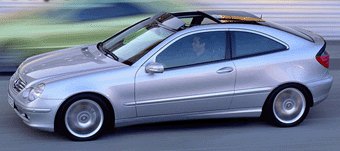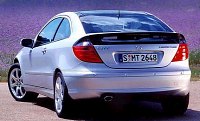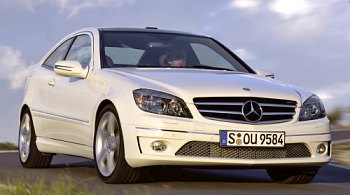|
Mercedes C-class Sports
Coupe / CLC-class (CL203)
Debut: 2001
Maker: Mercedes-Benz
Predecessor: no |
|
 After
watching BMW 3-series Compact for so many years, Mercedes decided to
build
a hatchback version of the C-class. However, instead of making it a
cheaper
alternative, Mercedes shaped it like a coupe - which means it looks far
more handsome than its rival - and gave it an up-market name: C-class
Sports
Coupe. After seeing it recently in showroom, I swear that the car is
really
attractive to eyes. After
watching BMW 3-series Compact for so many years, Mercedes decided to
build
a hatchback version of the C-class. However, instead of making it a
cheaper
alternative, Mercedes shaped it like a coupe - which means it looks far
more handsome than its rival - and gave it an up-market name: C-class
Sports
Coupe. After seeing it recently in showroom, I swear that the car is
really
attractive to eyes.
What
separate it from the sedan ? firstly, most apparent is the 3-door body
with 180 mm boot chopped and replaced that by a liftback. Additional
strengthening
required for the tail’s big opening makes it just 10 to 15kg lighter
than
the saloon. With rear seats down, it provides a 1100-litre luggage
space,
exactly the same as the 3 Compact. Despite of 20 mm lower roofline and
a fastback tailgate, rear seats are still roomy enough to swallow a
couple
of 6-footers. Optional electric glass roof eats into headroom but it
makes
the cabin feels light and airy.
The
second change is stiffer springs and dampers. The standard setup is
roughly
between the saloon’s standard setup and sports setup, while the sports
setup is another 10% stiffer. This results in a ride slightly firmer
than
the saloon while providing marginally better control and agility.
Considering
the high achievement of the saloon, you might think the Sports Coupe
must
beat the new Compact in handling ? wrong, because the new Compact has
been
tuned even sportier, overshadowing the Mercedes in every dynamic
aspects
(including steering feel) while matching its ride. The Sports Coupe is
taut and grippy, steers accurately and feels agile, but being a coupe
it
faces some rivals offering greater feedback and quicker response. It
works
best at 80% rather than at limit.
 Market
positioning could be tricky, because Mercedes has already got a CLK
coupe
(based on last generation C-class) above it. It marginally undercuts
the
saloon with equivalent engines, so budget-limited buyers are left to
316ti
Compact. C180 Sports Coupe is slow and expensive, so unless you want
its
badge and design it is not a very sensible buy. Unluckily, other
versions
are not much better - 163hp C200K and 197hp C230K are powered by
supercharged
fours which are notorious about NVH. No match with BMW’s 2.5-litre six
at all. Although the 230K provides quite good performance (even in
automatic),
the engine sounds coarse and feels reluctant above medium rev,
preventing
the driver from enthusiastic flat out. Market
positioning could be tricky, because Mercedes has already got a CLK
coupe
(based on last generation C-class) above it. It marginally undercuts
the
saloon with equivalent engines, so budget-limited buyers are left to
316ti
Compact. C180 Sports Coupe is slow and expensive, so unless you want
its
badge and design it is not a very sensible buy. Unluckily, other
versions
are not much better - 163hp C200K and 197hp C230K are powered by
supercharged
fours which are notorious about NVH. No match with BMW’s 2.5-litre six
at all. Although the 230K provides quite good performance (even in
automatic),
the engine sounds coarse and feels reluctant above medium rev,
preventing
the driver from enthusiastic flat out.
While
the saloon and CLK have 3.2 V6 to choose from, Mercedes decided to
limit
the Sports Coupe to four-pots only to avoid internal competition. This
is of course a big mistake, because the V6 would have made the Sports
Coupe
a really desirable car. It beats the Compact easily in beauty contest.
It offers more room. It doesn’t handle as well but still good enough.
What
it desperately need is a decent engine. Listen, Stuttgart, give it a V6
as soon as possible ! |
| The
above report was last updated on 19 May
2001. All Rights Reserved. |
M271 four-cylinder engines
|
In mid-2002,
Mercedes introduced a new 4-cylinder engine family to replace the
notorious
existing four-cylinders. The M271 family is a clean-sheet design. It
has
various new features to improve efficiency and refinement. First of
all,
there is twin-balancer shafts to eliminate the inherent vibration of
inline
4-cylinder engines. Secondly, the cylinder head now employs variable
valve
timing at both intake and exhaust side. Thirdly, roller cam followers
and
hydraulic lifters are used to reduce friction and noise. Fourthly, all
M271 engines have a more efficient supercharger and intercooler than
the
old one. Reduced clearance between the supercharger housing and
compression
roller reduces gas leakage thus the small supercharger can produce
higher
boost pressure. Lastly, by using smaller supercharger, reduced capacity
to 1.8-litres (from 2.0 or 2.3-litre) and an aluminum crank case, the
engine
is smaller and lighter. For example, the engine for C200 Kompressor
weighs
167kg, some 18kg lighter than the old 2.0-litre unit which produced the
same power.
At the moment
of
writing,
M271 family consists of 4 engines. Surprisingly, all of them displace
1.8
litres.
Different
combinations of
output and fuel consumption are implemented by different tuning, e.g.,
different supercharging pressure and compression ratio. The only
exception
is the CGI engine (CGI - Stratified Charge Gasoline Injection), which
employs
direct fuel injection. As usual, direct injection not only saves fuel,
but also increases power by allowing higher compression ratio. The 4
engines
are:
|
Model
|
Eng
capacity
|
Compression
ratio
|
Power
|
Torque
|
|
180
Kompressor
|
1796
cc
|
10.0
:
1
|
143hp
/ 5200rpm
|
162
lbft / 2500rpm
|
|
200
Kompressor
|
1796
cc
|
9.3
: 1
|
163hp
/ 5500rpm
|
177
lbft / 3000rpm
|
|
200
CGI
|
1796
cc
|
10.3
:
1
|
170hp
/ 5300rpm
|
184
lbft / 3000rpm
|
|
230
Kompressor
|
1796
cc
|
8.5
: 1
|
192hp
/ 5800rpm
|
192
lbft / 3500-4000rpm
|
As you can
see,
Mercedes
has given up its naming theory according to engine size and uses a
performance-rating
system like AMD's Athlon XP processors.
Compare
with the
old 4-cylinder,
the M271 family is much smoother, quieter and much more frugal.
Mercedes
finally has a world-class four-cylinder engine to match its superb V6,
V8 and V12. |
| The
above report was last updated on 8 July
2003. All Rights Reserved. |
C-class Sports Coupe with new engines
|
C-class
Sports Coupe used to be an example of how an excellent car ruined by a
poor engine. At its launch, it was offered with either an under-powered
2.0-litre four or a pair of noisy and vibrating supercharged four (2.0
or 2.3 Kompressor). We questioned why Mercedes didn't supply it with a
V6. Anyway, in mid-2002, Mercedes finally added the 218hp 3.2 V6 into
the
sales menu, primarily for the US market. Then, a new four-cylinder
model
consisting of 4 engines replaced the old four-cylinders.
The 4-cylinder
series included
C180 Kompressor (143hp / 162 lbft), C200 Kompressor (163hp / 177 lbft),
C200 CGI (170hp / 184 lbft) and C230 Kompressor (192hp / 192 lbft). The
entry-level unit is considerably more torquey than the old C180 Sports
Coupe, thanks to supercharger, thus real-world performance suffers
little
from the old car's sluggish response. In fact, its performance is
easily
more accessible at low and mid-rev than BMW 318ti Compact, while good
refinement
should put smile on your face.
At
the upper end,
the C230
Kompressor loses a bit power and torque from its predecessor, as engine
displacement has been reduced from 2.3 to 1.8 litres. Inevitably,
performance
eased back a little (0-60mph is now 8.1 sec), but the smooth and
quieter
power delivery is more than enough to compensate. In the past, the more
you ask from the engine, the more unhappy it becomes. In contrast, the
new engine adds to driving fun. |
| The
above report was last updated on 8 July
2003. All Rights Reserved. |
CLC-class
|

|
A facelift too late and too little
cannot clear the question mark over its future
|
Although
Mercedes has renewed its C-class for one year, it has no intention to
renew the 7-year-old C-class Sports Coupe in the same way. What the
latter gets is just a facelift accompany with a new name, CLC-class,
which is necessary to distinguish with the new C-class. Does this mean
Stuttgart plan to discontinue the line in a few years time ? Probably.
In order to restore your confidence in the aging model, Mercedes
claimed the CLC has got 1100 new parts. Many of them are used at the
new nose which resembles the new C-class Avantgarde. Unfortunately the
facelift does not make it any prettier. You will find the new nose
design too angular to work in harmony with the sleek body. The front
overhang is also too long for a compact hatchback. At the other end,
the new tailgate has discarded the lower glass section, which results
in poorer visibility. More disappointing is the interior, which needs a
quality upgrade desperately but unfortunately it remains unchanged. The
old car was born at a time when quality was no longer the first
priority at Mercedes-Benz. Today you could find a Ford Mondeo or Honda
Accord employs classier materials in their cabins. Even though the CLC
gets a better steering wheel, seats and some equipment upgrade, it is
difficult to persuade people to spend so much money on it.
In the mechanical side, the new CLC gets very limited improvements too
- the suspensions has sportier setup, while the steering gets a
variable-ratio rack for more responsive steer in tight corners. They
make the CLC more fun to drive, but the old C-class chassis cannot hide
its age and this prevent it from matching its rivals in handling. There
are some minor changes to the engines, but none of them are exactly new
to Mercedes. Sadly, the range-topping 3.5-liter V6 still produces 272
horsepower, i.e. without the 305hp upgrade that we have found in SLK
recently.
Overall speaking, the CLC is a facelift that came too late and too
little. It is no longer as likable as a few years back. |
| The
above report was last updated on 2 May 2008. All
Rights Reserved. |
|
|